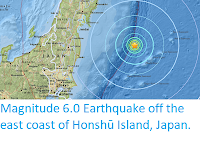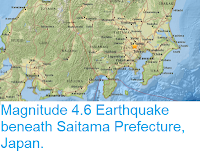One man has died and at least fifteen more have been injured in a rockfall triggered by an eruption on Mount Kusatsu-Shirane, a 2160 m stratovolcano (cone-shaped volcano made up of layers of ash and lava) in Gunma Prefecture on Honshū
Island, Japan, on Tuesday 23 January 2018. The eruption occured at about 10.00 am local time, and resulted in rocks being thrown several hundrad meters into the air. The dead man, along with several of those injured, is described as having been a member of the Japanese National Defece Force who was on a training exercise at the time of the eruption.
Cloud of ash over Mount Kusatsu-Shirane following an eruption on 23 January 2017. Yomiuri Shimbun.
Japan has a complex tectonic situation, with parts of the country on
four different tectonic plates. Kyushu Island lies at the northeast end of the Ryukyu Island Arc, which
sits on top of the boundary between the Eurasian and Philippine Plates.
The Philippine Plate is being subducted beneath the Eurasian Plate, in
the Ryukyo Trench, to the Southeast of the Islands. As it is drawn into
the interior of the Earth, the tectonic plate is partially melted by the
heat of the Earth's interior, and liquid magma rises up through the
overlying Eurasian Plate to form the volcanos of the Ryukyu Islands and
Kyushu.
The movement of the Pacific and Philippine Plates beneath eastern Honshu. Laurent Jolivet/Institut des Sciences de la Terre d'Orléans/Sciences de la Terre et de l'Environnement.
See also...
Follow Sciency Thoughts on Facebook.








